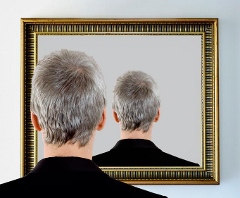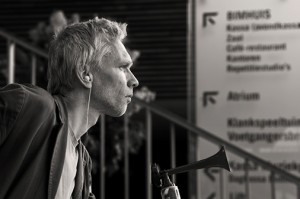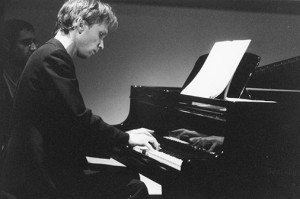A HARD-HAMMERED POUNDING FROM VAN HOUDT
As part of his current U.S. tour, pianist Reinier Van Houdt stopped at REDCAT to perform concerti from three experimental composers: Jerry Hunt, Luc Ferrari, and Walter Marchetti. Van Houdt played both piano and various accompaniments for the works, each one unusually orchestrated with random small percussive instruments, a tape recorder, and even an umbrella.
Van Houdt is on an apparent mission to live curate experimental piano works that often lack catchy melody and tonal warmth, songs that make most listeners long for more familiar harmonic waters. Notwithstanding flawless execution, his selections were fleetingly melodic, rhythmically hyper-complex, and often containing non-harmonic tones—a combination that creates an aural chore better-suited for the fine-tuned ears of music theorists and devotees of minimalism. However, his genre-blurring credence lets the audience let go of preconceptions and the gross predictability of the thirty-two bar form.
Van Houdt opened with a variation of Hunt’s Chimanzzi for piano and percussion. The piece is a melting pot of inharmonicity and teasing chromatics that converse with one another genially until they are blatantly interrupted by jarring bouts of percussive purging. Chimanzzi is interesting, but lacks comprehension and sustained beauty.
Ferrari’s 1985 composition of mini-suites for piano and tape recorder, 36 Enfilades, begins with a pounding assault (Van Houdt dramatically slapping and jabbing the keys with his entire forearm, elbow, and flattened palms) that gradually morphs into variations of a tinkling melodic theme on piano intertwined with a tape recorded French narrative. Van Houdt chose a tape player with a particularly loud pause button that he presses and uses as a subtle yet very deliberate coda for each of the variations. In spite of its simplicity, the intriguing 36 Enfilades is demanding. Van Houdt puts his entire body into the variations, taking brief composure breaks in between some of the more aggressive enfilades.
Marchetti’s 1994 Concerto per la mano sinistra for piano and umbrella is a left-handed concerto played with the right hand so that the left hand can hold an umbrella. The work is comprised largely of soft two-note chords executed to resonate through the emergence of subsequent chords, mimicking the patter of rain as the performer holds a large umbrella. Both as piano solo and absurdist performance art, the piece is alluring for the first few minutes, but eventually the umbrella gimmick wears off and the music lulls the listener into deep contemplative thought (or boredom, if minimalism isn’t your bag). Marchetti’s concerto is graceful, but leaves one longing for perky complexity and canorous elaboration.
Regardless of music selection, Van Houdt is a pleasure to watch and hear. As much a curiosity as his experimental leanings, he does not hide behind traditional bantering showmanship. He enters the stage, pounds the hell out of his piano in a focused torrent, and then modestly leaves the stage after giving the audience a few stoic nods. Despite a deceptively lanky frame, his technique is plucky, precision driven, and surprisingly powerful. His sound often thrillingly and unexpectedly swarms the audience, amplifying hammered keys through sheer force. The concerti chosen for the REDCAT performance demanded that he detach from his aloof exterior to imbue each and every note with bravado. He undertook this artful task painstakingly.
Van Houdt rarely makes it stateside. If you can interpret the mess of flaming pianos and cryptic US tour news on his website, you may be able to catch him and his umbrella before he heads home to Netherlands.
photos courtesy of the artist
poster photo by Martijn von Hennik
Reinier van Houdt
REDCAT
Roy and Edna Disney/CalArts Theater
at Walt Disney Concert Hall
played on March 21, 2014
for future REDCAT events, call 213-237-2800 or visit www.REDCAT.org
for tour info, visit www.reiniervanhoudt.nl




{ 1 comment… read it below or add one }
Acoustics are subtle in conscious perception. We constantly adjust our hearing to interior design and architecture, but just as we are unaware of the color shift when someone walks through the shade of a tree, we do not register the affect of acoustics unless we can’t understand the words.
And yet, music is not notes, it is sound. How the music interacts with the environment makes a big difference in how we feel, and it is obvious Ms. Bonadonna was not as comfortable with this music as Mr. Smith.
Acoustic are not good, better and best – they are appropriate or not; and acoustics that work best for theater or even opera are unsuited to instrumental music. Proscenium arches disrupt concert acoustics, taking away warmth and intimacy unless the musicians are surrounded by carefully angled 3/4″ thick baffles on three sides and overhead. This in part accounts for two very different reactions in print to Mr. van Houdt. His New York engagement was in a room built around a piano, in LA a dramatic theater.
Another factor is this: speakers designed from the evolution of Public Address (speech amplification) have timbral, temporal and spatial distortions that conflict with physical instruments. The speakers in REDCAT are optimized for speech intelligibility, while the ones used for the Ferrari piece at SpectrumNYC are designed for musicality and conversely not good for spoken word. At the least, staging a duet between piano and electronics requires that the speakers be proximal to the piano and at the same height; and that they match the transient peak dynamics of a concert grand, which means conventional horn radiators are not appropriate.
Program Directors need to get over the myth of “mixed use” unless they have the budget to change the walls and ceiling between performances and mount two sets of amplification gear. For example, speech based performances work best in wide, shallow rooms and music in narrow, deep halls – so you could have a proscenium on the long wall and a music stage on the short wall, rotating the seats to face the music.